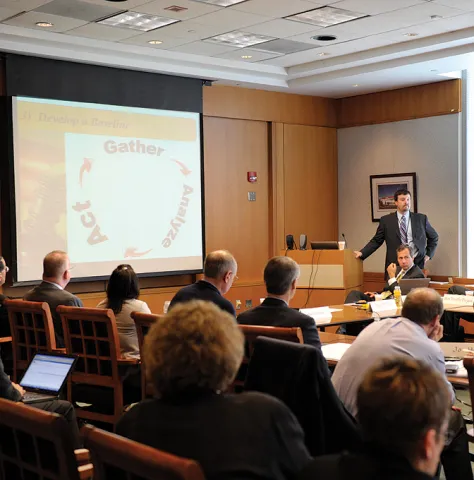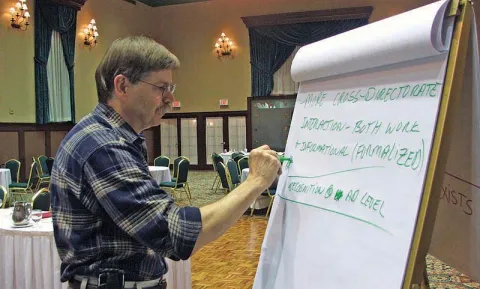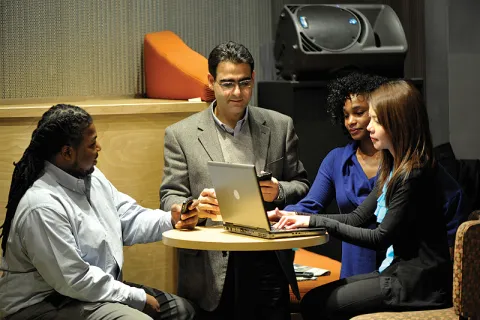
Infrastructure improvements, security testing, and consolidation of vendor management programs were several areas examined by information technology forums and committees.
CM/ECF Status
By 2003, the majority of the courts had implemented CM/ECF, and now the system is used in virtually all district, bankruptcy and circuit courts, in the Court of Federal Claims, and the Court of International Trade. And work is underway with the Judicial Panel on Multidistrict Litigation to determine if it, too, can benefit from CM/ECF. The volume of electronic filings continues to grow, with over 5 million documents filed each month and nearly 450,000 attorneys using the electronic filing feature. Attorney electronic filings now account for 40 percent of the docket entries in district courts. In the bankruptcy courts, attorneys electronically enter 70 percent of all docket entries and 90 percent of all case openings. Staff continuously work with the appellate, district, and bankruptcy courts to further enhance CM/ECF to meet additional user needs. New software releases are regularly delivered to provide new functions and features. Recent releases have focused especially on delivering added features for chambers use. In addition, new servers are now being delivered to the courts. These new servers are significantly more powerful than the old servers they are replacing and should provide excellent reliability and performance for all courts.
Planning for the Future
Now that the Judiciary has had over a decade of hands-on experience with CM/ECF and the progressive changes that it has enabled, the courts are evaluating more comprehensively their business processes and their system needs for the future. This CM/ECF “Next Generation” project—endorsed by the Judicial Conference Committees on Court Administration and Case Management, Information Technology, and Administration of the Bankruptcy System—is now well underway. Integrated efforts in the bankruptcy, district, and appellate communities, are defining the requirements for a next generation system.
More than 5 million documents are electronically filed in the courts each month, and nearly 450,000 attorneys file electronically.
Steering groups and work groups made up of judges, clerks and court staff, and management groups and support teams from the AO, have been created to guide and accomplish the work of the project. Groups are looking at chambers, clerk’s office and additional stakeholder needs. All judges and court staff will have numerous opportunities to become involved in the requirements-gathering process. Group discussions are being held at various locations around the country where judges and others can meet face-to-face with their colleagues to discuss how they do their work and how a new CM/ECF could help them work more efficiently. Ideas from all the various sources are being assessed by the workgroups, and those developed into written requirements are being posted on the J-Net for review and comment by the full Judiciary community.
Operational Practices Forums
CM/ECF Operational Practices Forums have been a valuable way for users to discuss experiences, issues, and practices. The Bankruptcy and District Court Administration Divisions, with faculty assistance from the FJC, have held forums for both bankruptcy and district court users for the past several years.
In fiscal year 2009, both forums continued to offer courts the option of reviewing locally developed tools and applications and allowing the AO to share national updates. Nearly 600 judges, case administrators, chambers staff, and systems and operations managers attended the District Operational Practices Forum in Washington, D.C. Nearly 500 judges, chambers staff, clerks, deputy clerks, and AO staff attended the Bankruptcy Operational Practices Forum, hosted by the Northern District of Texas Bankruptcy Court. Audio files and notes of the forum sessions transcribed by volunteer court personnel have been posted on the Judiciary’s intranet site.
Voice, Video, and Data Communications Services

Electronic case management and filing has been successful because ideas and requirements from stakeholders have been collected and applied to shape the system. With the CM/ECF Futures project, that approach continues.
In July, AT&T was awarded the Judiciary National Networx Order (JNNO) to provide the courts with voice, video, and data services through March 2017. Under the GSA Networx Universal Contract, JNNO replaces the FTS2001/Sprint services contract that ends in May 2011. The Judiciary’s transition from FTS/Sprint to Networx/AT&T began last summer and will conclude in early FY 2011. The GSA Networx contracts are designed to provide the federal government with the lowest cost telecommunications services available, based on volume pricing.
Communications Infrastructure Improvements
AO information technology staff and the IT Security and Network Management Working Group have together planned and coordinated infrastructure improvements to help courts leverage the capabilities provided through the Networx contract. Improvements focus on two key areas.
Local Area Network Assessments
The AO is offering two types of assessments to help courts maintain peak network performance: a comprehensive on-site assessment of the local communications infrastructure, and a smaller-scale remote assessment that assists courts in reviewing requirements through conference calls and email. To date, eight on-site and seven remote assessments have been conducted, and another seven assessments have been scheduled for 2010. A multi-year contract is being developed to provide this service to 20 or more courts annually.
Network Management
Since the AO made available the Observer Network Management toolset in December 2008, nearly every court in the Judiciary has requested it. The Observer tool enables local court IT staff to readily identify, analyze, and resolve network performance issues and gives the Judiciary a standard tool to assess network problems. More than 600 court staff received training on the tool through sessions at each of the five 2009 circuit IT conferences and customized webinars. Computer-based training modules on networking technology also were produced.
Information Technology Security Initiatives

Courts are able to purchase IT equipment and many services locally through contracts that the Administrative Office negotiates at the national level.
IT Security is a major AO priority. Staff are developing services and flexible contract options vehicles to enhance the Judiciary’s IT security posture.
Circuit-Level Security Assistance Program
An AO pilot program makes available at the circuit level a full-time IT security expert to support the security needs of individual courts. The specialist would work in the circuit executive’s office to create security designs, track vulnerabilities, optimize security and network management tools, conduct security awareness training, and assist network managers in mitigating identified risks.
The Administrative Office helped place circuit-level IT security experts in the District of Columbia, and in the First and Tenth Circuits. In addition, the Second, Third, and Sixth Circuits have hired dedicated government IT security staff. AO staff talk weekly with these circuit-level IT security experts to identify national trends and areas for improvement.
Comprehensive Contracting Vehicle for Security Services
Court and Administrative Office staff are defining requirements for a comprehensive court security services contract. A wide range of IT security services would be available to the courts, including: vulnerability scanning; penetration testing; web application testing; anti-virus management; security incident response desks; management and support for audit log coordination; design and implementation of intrusion detection and intrusion prevention systems for local-area networks; planning and implementation for desktop, laptop, and removable media encryption; design, integration, and implementation for secure wireless systems; security training and awareness programs; and general security support.
Court IT Security Assessments
A pilot program is underway that provides on-site assessments by a team of security experts who analyze the local IT security framework and provide court units with a confidential report detailing findings and ways to enhance technology security locally. The Eastern District of Arkansas, the Pretrial Services Office in the Central District of California, and several units in the Third Circuit have piloted the program. The Administrative Office will expand the program in 2010, offering the service to other federal courts nationwide.
Security Testing
In addition, security testing is being performed on nationally supported applications. Penetration testing is performed using state-of-the-art commercial penetration and assessment tools, and is based on recognized government and industry standard best practices and benchmarks.
Consolidated Vendor Management Program
OIT identified new and previously unsupported court needs and negotiated with numerous vendors to realize savings to the Judiciary:
Novell Support: AO staff analyzed actual court utilization of Novell software products and technical support services to negotiate a more than $1 million reduction in costs for the final two years of the contract.
Server Maintenance: Several hundred thousand dollars will be saved annually after negotiations with the providers of the Judiciary’s national servers and hardware maintenance support. Improvements in server technology and reliability are the basis for savings.
IT Vendor Management: Information technology technical contracts will be managed as a comprehensive portfolio to eliminate unnecessary overlap and better acquire and utilize major IT equipment and services.
IT Improvements at the Administrative Office
Several IT improvement efforts this past year provided AO staff with a reliable, mobile, and secure IT environment to better serve court customers. The AO desktop upgrade provided AO users with an improved standard desktop configuration coupled with significant network management upgrades. These are resulting in measurably reduced security vulnerabilities and improved help desk support. As the AO moved to a more mobile environment during FY 2009, the need arose to protect laptops if they were lost or stolen. In response, the AO completed a laptop encryption effort.
The AO’s disaster recovery capabilities were enhanced in 2009. Additional IT infrastructure changes and related employee training have positioned the AO to respond to the H1N1 pandemic threat, allowing users to work remotely while keeping data secure.
Growing Teleconference Services
Several highly visible and successful teleconferences highlighted the value of these services and the benefits in continuing to enhance them. A number of meetings between former and sitting judges, the State Department, and Supreme Court delegations from several countries made good use of teleconferencing technology.
Annual Report 2009
- Annual Report 2009
- Legislative Activity
- Direct Impact On The Public
- Judges Programs
- Facilities, Security, and Emergency Planning
- Business Improvements, Studies, and Activities
- Key Studies and Activities
- Human Resources
- Technology
- Probation and Pretrial Services
- Defender Services
- Communications
- In Profile
- A Strategic Direction For The Administrative Office of the United States Courts, Fiscal Years 2009–2013
